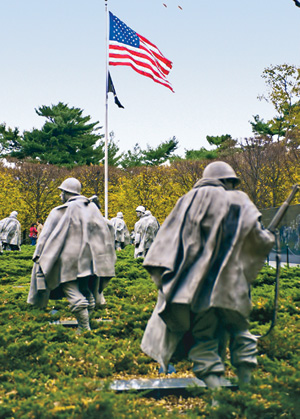From the Archives: Remembrance
by Stevie Daniels
On the bitter cold, sunny afternoon following Veterans Day this fall, the Purple Heart that had been awarded posthumously to 1st Lt. Henry A. Schenk ’43, a hero killed in action during the Korean War, was returned to his family in a ceremony at the National Korean War Memorial in Washington, D.C.
Noted actor-author James McEachin of Hollywood, whose life was saved by Schenk, presented the Purple Heart. McEachin was one of only two survivors from the squad of soldiers ambushed in August 1952 during a mission led by Schenk to rescue American prisoners. Schenk, who was executive officer of Company K, 3rd Battalion, U.S. Army, fought fiercely to save his men. McEachin, felled by a bullet in the leg, recalls seeing only one man still firing.
“It was Schenk,” McEachin was quoted in the Aug. 6 Raleigh, N.C., News & Observer. “He was the bravest man I’ve ever seen, or ever will see.”
McEachin, a Silver Star and Purple Heart recipient himself, had been searching for Schenk’s family ever since the war so that he could tell them how Schenk saved his life.
 The ceremony was organized by Capt. Zachariah Fike, a Vermont National Guardsman who founded the nonprofit Purple Hearts Reunited. Fike, who earned a Purple Heart during deployment to Afghanistan in 2010, has returned more than 50 medals to families.
The ceremony was organized by Capt. Zachariah Fike, a Vermont National Guardsman who founded the nonprofit Purple Hearts Reunited. Fike, who earned a Purple Heart during deployment to Afghanistan in 2010, has returned more than 50 medals to families.
Kimberly Paller presented Schenk’s medal with McEachin. She had found it in a box of books she bought at a yard sale in Pinehurst, N.C. She met McEachin at the 60th Anniversary of the Korean War Armistice in July and gave the medal to him. He passed it to Fike, who was trying to locate Schenk’s family with the assistance of Diane Shaw, director of Skillman Library’s special collections and College archivist, who also attended the ceremony. Peter Schenk Jr. ’70, son of Henry’s brother, Peter Schenk ’45, and other family members attended the ceremony. Peter Sr., a colonel in the Air Force, had a 39-year military career.
Schenk is among 159 Lafayette alumni who died while in military service to the United States during war whose names are engraved on the granite walls of Alumni Memorial Plaza. The plaza was made possible by a contribution from Bill Lanigan ’51, a veteran of the Korean War who received the Bronze Star. He and Gen. Alfred M. Gray Jr. ’50, commandant of the U.S. Marine Corps from 1987 to 1991, spoke at the dedication in 1989.
The plaza is located in front of Alumni Memorial Gymnasium (now Oechsle Hall), which was completed in 1924 as a memorial to alumni who had fallen in World War I.
EARLY DAYS
When the College was founded in 1826, the first academic program proposed was “a course of practical military science with the course of literature and general science,” but this plan was never executed. When George Junkin became president in 1832, the focus was changed to a mechanical and agricultural program with the substitution of a manual labor system for military training.
In September 1918 the College became “Camp Lafayette,” as one of the academic institutions participating in the Student Army Training Corps (SATC). Nearly 600 students began the military and educational program in October. Civilian students numbered 63. In five weeks armistice was declared; the program ended in December.
One of the first Lafayette men to be killed in the World War was Peyton C. March Jr. ’19, son of Gen. Peyton C. March 1884, Army chief of staff 1918-1921. Theodore Roosevelt wrote to General March—shortly before his own son Quentin was killed in France—“You have already drunk of the waters of bitterness; I suppose I shall soon have to drink of them; but whatever befalls, you and I hold our heads high when we think of our sons.”
In 1919, military training became a regular and permanent part of the curriculum with the establishment of a unit of the Reserve Officers Training Corps (ROTC). The courses were electives open to all students, putting into practice the vision founders had for the College nearly 100 years before.
By 1941 enrollment at the College had reached 900, but by 1942 only 225 students remained. Then Lafayette was chosen by the War Department as one of 36 academic institutions to be a training center for engineering and aviation cadets. The number of servicemen on campus grew to 1,200. Among those who came for Foreign Area and Language Division training were future secretary of state Henry Kissinger and future Idaho senator Frank Church. Brent Scowcroft, who later served as National Security Advisor, attended the West Point Preparatory Program held on campus at that time.
In 1945 the programs ended, but postwar enrollment surged, fueled by returning veterans taking advantage of the education benefits of the G.I. Bill.
[NOTE: A Book of Remembrance dedicated to the Lafayette alumni who died fighting in World War II is held in Skillman Library’s Special Collections and in the digital archive.]
ROTC was made a requirement in 1950. Students demonstrated against it in 1963, 1964, and 1967. In May 1969 about 60 students tried to disrupt the ROTC annual review and awards ceremony, which involved 500 cadets. They were disciplined. In 1970, the requirement was removed. The program was offered jointly with East Stroudsburg State College, and later with Lehigh University, as it is today.